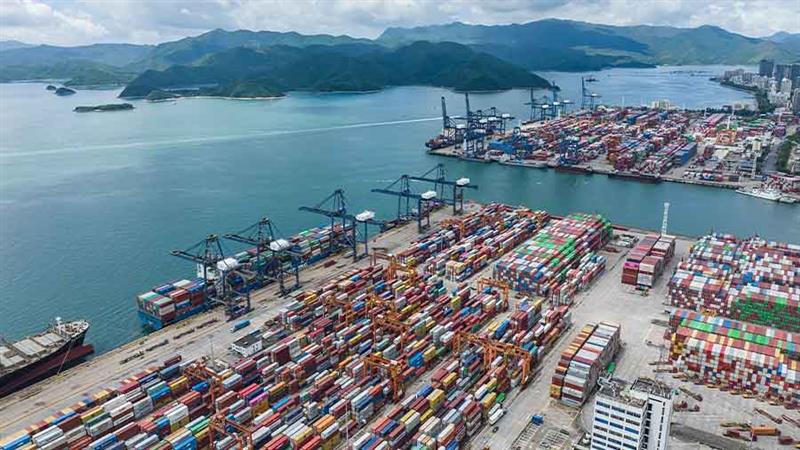Economic Indicators and China's GDP, FDI, and Trade Trends
Gross Domestic Product growth and 2023 forecast

GDP target set at “around 5 percent”
During the 2024 Two Sessions, the government announced a GDP growth target of “around 5 percent” for 2024, consistent with the target set in 2023.
This target exceeds the expectations of some international institutions. The IMF predicts China’s GDP to grow at 4.6 percent year-on-year in 2024, while JPMorgan predicts a 4.9 percent increase. This demonstrates that the country’s policymakers remain confident in the country’s economic prospects.
Nevertheless, this growth target may be harder to reach in 2024 than in 2023. The relatively strong performance of the Chinese economy in 2023 will create a high base effect, which means the economy will need to maintain its upward trajectory if it is to maintain a similar growth rate as in 2023. By contrast, GDP growth in 2022 slowed to just 3 percent year-on-year, which made hitting the 5.2 percent growth rate in 2023 considerably more likely.
Given this, more direct efforts and policy measures may be needed to stimulate the economy throughout the year. The 2024 Government Work Report (GWR) indicates China will continue to implement a proactive fiscal policy and a prudent monetary policy, which might be too modest to achieve the ambitious 5 percent growth target.
On the one hand, in the 2024 GWR, the central government urges local governments and departments to introduce policies conducive to stabilizing expectations, promoting growth, and ensuring employment stability, while requesting them to exercise caution when implementing measures that may have a discouraging effect. Careful deployment of fiscal funds and supportive policies in key areas could help to boost the Chinese economy in 2024.
Foreign Direct Investment trends
While many areas of China’s economy rebounded in 2023, actual use of foreign capital in China fell by 8 percent year-on-year, although the number of new foreign-invested enterprises (FIEs) established in 2023 grew by 39.7 percent year-on-year.
Meanwhile, data released by the Ministry of Commerce (MOFCOM) released in February 2024 shows that the actual use of foreign capital in January fell by 11.7 percent year-on-year, reaching a total of RMB 112.71 billion (US$15.66 billion). However, January 2023 saw relatively high levels of foreign capital, creating a high base effect that negatively affected this year’s figures. On a month-by-month basis, foreign investment in January 2024 increased by 20.4 percent.
Boosting foreign capital was high on the policy agenda in 2023, with various documents released aimed at supporting its growth. The government also took several concrete steps to improve the business environment for foreign companies, such as proposing measures to ease cross-border data flows and relaxing rules for on-arrival business visas.
The 2024 GWR outlines specific measures to attract foreign investment. These include continuing to shorten the negative list for foreign investment access, which lists the industries that are restricted from foreign investment. The 2024 GWR specifically calls for completely removing market access restrictions in manufacturing fields and relaxing market access for telecommunications, medical, and other service industries.
Besides, it proposes expanding the Catalogue of Encouraged Industries for Foreign Investment and encouraging FIEs to reinvest earnings in the country.
The 2024 GWR also proposes a range of indirect measures to attract FDI. These include ensuring equal participation of FIEs in government procurement, promoting solutions to common headwinds faced by FIEs, such as restrictions on cross-border data flows, and facilitating procedures for foreigners to come to China for work, study, and travel.
Foreign investment inflows into China at the beginning of 2023 are off to a good start. In January, actual use of foreign capital amounted to RMB 127.7 billion, a year-on-year increase of 14.5 percent (in dollar terms, the amount reached US$19.02 billion, up 10 percent year-on-year).
This is a marked acceleration from the 6.3 percent year-on-year growth in December and is especially strong given the relatively high rate of growth recorded in January 2022 of 11.6 percent year-on-year. (Due to the very high level of growth in FDI inflows recorded in February 2022 – 37.9 percent – expect to see a slower growth rate in February 2023.)
The industries with the high growth in the actual use of foreign capital included:
- Manufacturing (40 percent year-on-year);
- High-tech (62.8 percent year-on-year);
- High-tech manufacturing (74.5 percent year-on-year); and
- High-tech services (59.6 percent year-on-year).
According to the State Council of People’s Republic of China, foreign direct investment (FDI) in the Chinese mainland, expanded 6.3 percent year on year to 1.23 trillion yuan in 2022. In U.S. dollar terms, the FDI inflow went up 8 percent year on year to 189.13 billion U.S. dollars.
The manufacturing industry saw FDI inflow increase by 46.1 percent year on year to 323.7 billion yuan in 2022, while that of hi-tech industries jumped by 28.3 percent compared with 2021, data from the ministry showed.
Investment from the Republic of Korea, Germany, and Britain, climbed by 64.2 percent, 52.9 percent, and 40.7 percent, respectively -- while that from the European Union registered a sharp rise of 92.2 percent year on year.
FDI flowing into the country's central region reported a year-on-year expansion of 21.9 percent, followed by 14.1 percent in the western region.
For comparison, in 2021, China’s actual use of FDI hit RMB 1.149 trillion. In US dollar terms, the FDI inflows came in at US$173.48 billion according to the Ministry of Commerce (MOFCOM).
As to the number of foreign-invested enterprises (FIEs), about 38,497 were registered in 2022.
China’s import and export statistics
China’s foreign trade has experienced meager growth in 2023. While the year got off to a strong start, with total trade volume rising by 4.8 percent year-on-year in the first quarter, the full-year growth slowed to just 0.2 percent. Total foreign trade reached RMB 41.76 trillion (US$5.86 trillion), with exports growing 0.6 percent to RMB 23.77 trillion (US$3.3 trillion), and imports decreasing by 0.3 percent to RMB 18 trillion (US$2.5 trillion).
High inflation and a cost-of-living crisis in key overseas markets – above all, the US and Europe – have reduced demand for imported Chinese goods in 2023, while domestic demand for imported goods has remained lackluster.
Trade with the EU and the US also showed signs of improvement in the fourth quarter, according to officials from China’s General Administration of Customs. Annual imports and exports with the EU and the US reached RMB 5.5 trillion (US$771.5 billion) and RMB 4.67 trillion (US$655 billion), accounting for 13.2 percent and 11.2 percent respectively. Meanwhile, bilateral trade with Latin America and Africa increased by 6.8 percent and 7.1 percent year-on-year respectively.
Moreover, private enterprises appear to have bucked the trend in 2023, recording a growth rate of 6.3 percent from 2022. Private companies also accounted for 53.5 percent of total imports and exports, an increase of 3.1 percentage points from the previous year.
The foreign trade figures also show that China continues to dominate in certain key export sectors, in particular mechanical and electrical products, as well as new technologies such as NEVs.
Exports of machinery and electronic products accounted accounting for 58.6 percent of the total export value, while exports of labor-intensive products accounted for 17.3 percent.
Within the field of machinery and electronic products, the export of electric passenger cars, lithium-ion batteries, and solar cells reached a combined export value of RMB 1.06 trillion (US$148.7 billion), breaking the trillion-yuan mark for the first time and growing 29.9 percent from 2022. Exports of ships and household appliances also increased by 35.4 percent and 9.9 percent year-on-year respectively.
Despite this, trade figures improved in the last few months of 2023, and the positive growth rate pertained to the first two months of 2024. At the beginning of 2024, foreign trade experienced a major improvement, increasing by 8.7 percent from the same period in 2023 to reach RMB 6.61 trillion (US$918.14 billion). This is the fastest growth rate recorded since April 2023.
Of the total trade in January and February, exports increased by 10.3 percent for a total of RMB 3.75 trillion (US$520.88 billion), while imports grew 6.7 percent year-on-year to RMB 2.86 trillion (US$397.26 billion).
| China Economic Profile (1990-2020) | ||||
| 1990 | 2000 | 2010 | 2020 | |
| World view | ||||
| Population, total (millions) | 1,135.19 | 1,262.65 | 1,337.71 | 1,402.11 |
| Population growth (annual %) | 1.5 | 0.8 | 0.5 | 0.3 |
| Surface area (sq. km) (thousands) | 9,600.00 | 9,600.00 | 9,600.00 | 9,600.00 |
| Population density (people per sq. km of land area) | 120.4 | 134 | 141.9 | 148.8 |
| Poverty headcount ratio at national poverty lines (% of population) | .. | 49.8 | 17.2 | 0.6 |
| Poverty headcount ratio at $1.90 a day (2011 PPP) (% of population) | 66.3 | 40.3 | 11.2 | .. |
| GNI, Atlas method (current US$) (billions) | 374.17 | 1,181.51 | 5,801.86 | 14,880.75 |
| GNI per capita, Atlas method (current US$) | 330 | 940 | 4,340 | 10,610 |
| GNI, PPP (current international $) (billions) | 1,118.30 | 3,642.99 | 12,325.79 | 23,491.51 |
| GNI per capita, PPP (current international $) | 990 | 2,890 | 9,210 | 16,810 |
| People | ||||
| Income share held by lowest 20% | 8.3 | 6.5 | 5.1 | .. |
| Life expectancy at birth, total (years) | 69 | 71 | 74 | 77 |
| Fertility rate, total (births per woman) | 2.3 | 1.6 | 1.6 | 1.7 |
| Adolescent fertility rate (births per 1,000 women ages 15-19) | 20 | 10 | 7 | 8 |
| Contraceptive prevalence, any methods (% of women ages 15-49) | 85 | 84 | 89 | 85 |
| Births attended by skilled health staff (% of total) | 94 | 97 | 100 | .. |
| Mortality rate, under-5 (per 1,000 live births) | 54 | 37 | 16 | 8 |
| Prevalence of underweight, weight for age (% of children under 5) | 12.6 | 7.4 | 3.4 | .. |
| Immunization, measles (% of children ages 12-23 months) | 98 | 84 | 99 | 99 |
| Primary completion rate, total (% of relevant age group) | 102 | 91 | 98 | .. |
| School enrollment, primary (% gross) | 127.5 | 112.3 | 99 | 103.2 |
| School enrollment, secondary (% gross) | 37 | 60 | 88 | .. |
| School enrollment, primary and secondary (gross), gender parity index (GPI) | 1 | 1 | 1 | 1 |
| Prevalence of HIV, total (% of population ages 15-49) | .. | .. | .. | .. |
| Environment | ||||
| Forest area (sq. km) (thousands) | 1,571.40 | 1,770.00 | 2,006.10 | 2,199.80 |
| Terrestrial and marine protected areas (% of total territorial area) | .. | .. | .. | 14.6 |
| Annual freshwater withdrawals, total (% of internal resources) | 18.4 | 19.6 | 21.3 | 21 |
| Urban population growth (annual %) | 4.3 | 3.6 | 3.3 | 2.2 |
| Energy use (kg of oil equivalent per capita) | 767 | 899 | 1,955 | .. |
| CO2 emissions (metric tons per capita) | 1.91 | 2.65 | 6.33 | 7.41 |
| Electric power consumption (kWh per capita) | 511 | 993 | 2,944 | .. |
| Economy | ||||
| GDP (current US$) (billions) | 360.86 | 1,211.35 | 6,087.16 | 14,722.73 |
| GDP growth (annual %) | 3.9 | 8.5 | 10.6 | 2.3 |
| Inflation, GDP deflator (annual %) | 5.7 | 2.1 | 6.9 | 0.7 |
| Agriculture, forestry, and fishing, value added (% of GDP) | 27 | 15 | 9 | 8 |
| Industry (including construction), value added (% of GDP) | 41 | 46 | 46 | 38 |
| Exports of goods and services (% of GDP) | 14 | 21 | 27 | 18 |
| Imports of goods and services (% of GDP) | 11 | 19 | 24 | 16 |
| Gross capital formation (% of GDP) | 34 | 34 | 47 | 43 |
| Revenue, excluding grants (% of GDP) | .. | .. | 11.2 | 16.5 |
| Net lending (+) / net borrowing (-) (% of GDP) | .. | .. | .. | .. |
| States and markets | ||||
| Time required to start a business (days) | .. | .. | 32 | 9 |
| Domestic credit provided by financial sector (% of GDP) | .. | .. | .. | .. |
| Tax revenue (% of GDP) | .. | .. | 10.2 | 9.1 |
| Military expenditure (% of GDP) | 2.5 | 1.8 | 1.7 | 1.7 |
| Mobile cellular subscriptions (per 100 people) | 0 | 6.6 | 62.8 | 117.9 |
| Individuals using the Internet (% of population) | 0 | 1.8 | 34.3 | 70.6 |
| High-technology exports (% of manufactured exports) | .. | .. | 32 | 31 |
| Statistical Capacity Score (Overall Average) (scale 0 - 100) | .. | .. | 66 | 80 |
| Global links | ||||
| Merchandise trade (% of GDP) | 32 | 39 | 49 | 32 |
| Net barter terms of trade index (2000 = 100) | 102 | 100 | 82 | 86 |
| External debt stocks, total (DOD, current US$) (millions) | 55,301 | 145,937 | 742,756 | 2,349,389 |
| Total debt service (% of exports of goods, services and primary income) | 11.7 | 13.1 | 2.9 | 9.2 |
| Net migration (thousands) | -780 | -1,966 | -1,552 | -1,742 |
| Personal remittances, received (current US$) (millions) | 196 | 758 | 13,636 | 18,902 |
| Foreign direct investment, net inflows (BoP, current US$) (millions) | 3,487 | 42,095 | 243,703 | 187,170 |
| Net official development assistance received (current US$) (millions) | 2,030.60 | 1,749.00 | 671.9 | -590 |





















